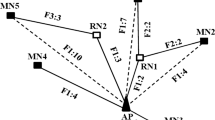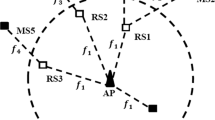Abstract
Loosely coupled interworking WLAN/cellular system has attracted a lot of attention recently, since the WLAN bandwidth is not restricted by the cellular network. In this kind of systems, a handoff from the WLAN to the cellular network is considered as a new call and therefore incurs a significant delay. Hence, the mobile station (MS) has to accomplish the handoff ahead of losing the WLAN coverage. In many cases the MS enters a region with a low bit rate before completing the handoff. This paper tries to aid the handoff by allocating the requested WLAN bandwidth to maintain the MS link with the serving access point as much as possible. In the case of WLAN bandwidth shortage, the handoff is assisted by using MS’s as ad hoc relay stations (RS’s) to extend the WLAN coverage. In a low-density WLAN, usually the handoff is accomplished by the aid of WLAN bandwidth. In contrast, in a high-density WLAN, the chance of finding a proper RS is high while the amount of available WLAN bandwidth is low. As a result, generally the handoff is accomplished by the assistance of potential RS’s. Both analytical and simulation results are provided to validate the effectiveness of the proposed method in terms of decreasing the call dropping probability.












Similar content being viewed by others
References
Ferretti, S., Ghini, V., & Panzieri, F. (2016). A survey on handover management in mobility architectures. Computer Networks, 94(2016), 390–413.
Zekri, A., & Jia, W. (2018). Heterogeneous vehicular communications: A comprehensive study. Ad Hoc Networks. https://doi.org/10.1016/j.adhoc.2018.03.010.
Hsieh, H. Y., Lin, Y. E., & Lin, H. P. (2008). Enhancing VoIP service for ubiquitous communication in a campus WLAN with partial coverage. Computer Networks, 52(13), 2489–2504.
Velmurugan, T., Khara, S., & Basavaraj, B. (2015). Modified handoff algorithm for providing optimization in heterogeneous wireless networks. Evolving Systems, 6(2015), 199–208.
Khadivi, P., Todd, T. D., Samavi, S., Saidi, H., & Zhao, D. (2008). Mobile ad hoc relaying for upward vertical handoff in hybrid WLAN/cellular systems. Ad Hoc Networks, 6(2), 307–324.
Fernndez, P. J., Santa, J., Pereguez, F., & Antonio, F. S. (2017). Towards seamless inter-technology handoffs in vehicular IPv6 communications. Computer Standard Interface, 52(2017), 85–96.
Murad Khan, M., & Han, K. (2014). An optimized network selection and handover triggering scheme for heterogeneous self-organized wireless networks. Mathematical Problem in Engineering (2014), Article ID 173068. http://dx.doi.org/10.1155/2014/173068.
Lee, W., Koo, J., Choi, S., & Park, Y. (2014). E$PA: Energy, usage ($), and performance-aware LTE-WiFi adaptive activation scheme for smartphones. In Proceeding of WoWMoM (pp. 1–9).
Choi, H. H. (2015). Ad hoc cooperative vertical handoff for next-generation heterogeneous networks. International Journal of Electronic and Communication (AEÜ), 69, 1557–1561.
Lin, Y. D., & Hsu, Y. C. (2000). Multihop cellular: a new architecture for wireless communications. In Proceedings of Infocom’00 (pp. 1273–1282).
Le, L., & Hossain, E. (2007). Multihop cellular networks: Potential, gains, research challenges, and a resource allocation framework. IEEE Communication Magazine, 45(9), 66–73.
Wu, H., Qiao, C., De, S., & Tonguz, O. (2001). Integrated cellular and ad hoc relaying systems: iCAR. IEEE Journal of Selection Areas Communications, 19(10), 2105–2115.
Zhao, D., & Todd, T. D. (2004). Real-time traffic support in relayed wireless access networks using IEEE 80211. IEEE Wireless Communications, 11(2), 32–39.
An, D., Kim, Y., Yoon, H., & Yeom, I. (2014). Partition and cooperation for crowded multi-rate WLANs. Wireless Personal Communications, 79(2), 1511–1538.
Jameel, F., Hamid, Z., Jabeen, F., Zeadally, S., & Javed, M. A. (2018). A survey of device-to-device communications: Research issues and challenges. IEEE Communication Survey Tutorials, 20(3), 2133–2168. https://doi.org/10.1109/COMST.2018.2828120.
Wu, H., De, S., Qiao, C., Yanmaz, E., & Tonguz, O. K. (2005). Hand-off performance of the integrated cellular and ad hoc relaying (iCAR) system. Wireless Networks, 11, 775–785.
Magagula, L. A., Chan, H. A., & Falowo, E. O. (2010). Handoff coordination with a relay-based design for heterogeneous wireless networks. In Proceeding of 35th annual IEEE local computer network conference (pp. 380–383).
Jeon, S., & Lee, S. (2007). A relay-assisted handover technique with network coding over multihop cellular networks. IEEE Communications Letters, 11(3), 252–254.
He, M., Todd, T. D., Zhao, D., & Kezys, V. (2004). Ad hoc assisted handoff for real-Time IEEE 802.11 infrastructure WLANs. In Proceedings of the IEEE WCNC 2004 (pp. 201–206).
Khadivi, P., Samavi, S., Saidi, H., Todd, T. D., & Zhao, D. (2006). Dropping rate reduction in hybrid Wlan/Cellular systems by mobile ad hoc relaying. Wireless Personal Communications, 39, 515–542.
Huang, R., Zhang, C., Zhao, H., & Fang, Y. (2011). Improving handoff performance by utilizing ad hoc links in multi-hop cellular systems. Wireless Networks, 17, 893–906.
Choi, H.-H., & Cho, D.-H. (2010). On the use of ad hoc cooperation for seamless vertical handoff and its performance evaluation. Mobile Networks and Applications, 15, 750–766.
Orsino, A., Gapeyenko, M., Militano, L., Moltchanov, D., Andreev, S., Koucheryavy, Y., & Araniti, G. (2015). Assisted handoff based on device-to-device communications in 3GPP LTE systems. In IEEE Globecom Workshops (pp. 1–6).
Huang, R., Zhao, H., & Fang, Y. (2013). Mitigating location management traffic via aggregation in multi-hop cellular networks. Wireless Networks, 19, 1563–1575.
Chiu, K. L., Hwang, R. H., & Chen, Y. S. (2011). Cross-layer design vehicle-aided handoff scheme in VANETs. Wireless Communications and Mobile Computing, 11, 916–928.
Bi, Y. (2018). Neighboring vehicle-assisted fast handoff for vehicular fog communications. Peer-to-Peer Networking and Applications, 11, 738–748.
Abdullah, R. M., Zukarnain, Z. A., & Iqbal, Z. (2017). Improved fast handover method for multiple node by using mobile nodes guide. Telecommunication System, 64, 429–438.
Xu, S., Zhu, G., Ai, B., & Zhong, Z. (2016). A survey on high-speed railway communications: A radio resource management perspective. Computer Communications, 86, 12–28.
Smadi, M., Azhari, V., Todd, T. D., & Kezys, V. (2009). A study of Wlan to cellular handoff using measured building exit data. IEEE Transactions on Vehicular Technology, 54, 2044–2054.
Khadivi, P., Todd, T. D., & Zhao, D. (2004). Handoff trigger nodes for hybrid IEEE 802.11 WLAN/cellular networks. In Proceeding of the 1st international conferance on quality of service in heterogeneous wired/wireless networks (Qshine 2004) (pp.164–170).
Nemati, H., & Azhari, S. V., Smadi, M. N., & Todd, T. D. (2010). Trigger node assisted WLAN to cellular vertical handover. In: IEEE 72nd vehicular technology conference-fall (VTC 2010 Fall), (pp. 1–5).
Roy, S. D., & Anup, S. (2012). Received signal strength based vertical handoff algorithm in 3G cellular network. In IEEE international conference on signal processing, communication and computing (ICSPCC 2012), (pp. 326–330).
Broch, J., Maltz, D. A., Johnson, D. B. Hu, Y.-C. Jetcheva, J. (1998). A performance comparison of multi-hop wireless ad hoc network routing protocols. In Fourth Annual ACM/IEEE international conference on mobile computing and networking (ACM MOBICOM) (pp. 85–97).
Hyytia, E., Lassila, P., & Virtamo, J. (2006). Spatial node distribution of the random waypoint mobility model with applications. IEEE Transaction on Mobile Computing, 5(6), 680–694.
Burgstaller, B., & Pillichshammer, F. (2009). The average distance between two points. Bulletin of the Australian Mathematical Society, 80, 353–359.
Kim, Y. S., Kwon, D. H., & Suh, Y. J. (2010). A client-based vertical handoff approach for seamless mobility across heterogeneous wireless networks. Wireless Communications and Mobile Computing, 10, 1208–1220.
Sreng, V., Yanikomeroglu, H., & Falconer, D. D. (2003). Relayer selection strategies in cellular networks with peer-to-peer relaying. In Proceedings of IEEE VTC’F03 (pp. 1949–1953).
ColucciaI, A., & Fascista, A. (2018). On the hybrid TOA/RSS range estimation in wireless sensor networks. IEEE Transaction on Wireless Communications., 17, 361–371.
Author information
Authors and Affiliations
Corresponding author
Additional information
Publisher's Note
Springer Nature remains neutral with regard to jurisdictional claims in published maps and institutional affiliations.
Rights and permissions
About this article
Cite this article
Shiri, M., Berangi, R. & Khadivi, P. WLAN Bandwidth-Based Handoff from WLAN to Cellular Network Assisted by Ad hoc Relaying. Wireless Pers Commun 114, 1597–1622 (2020). https://doi.org/10.1007/s11277-020-07441-9
Published:
Issue Date:
DOI: https://doi.org/10.1007/s11277-020-07441-9




